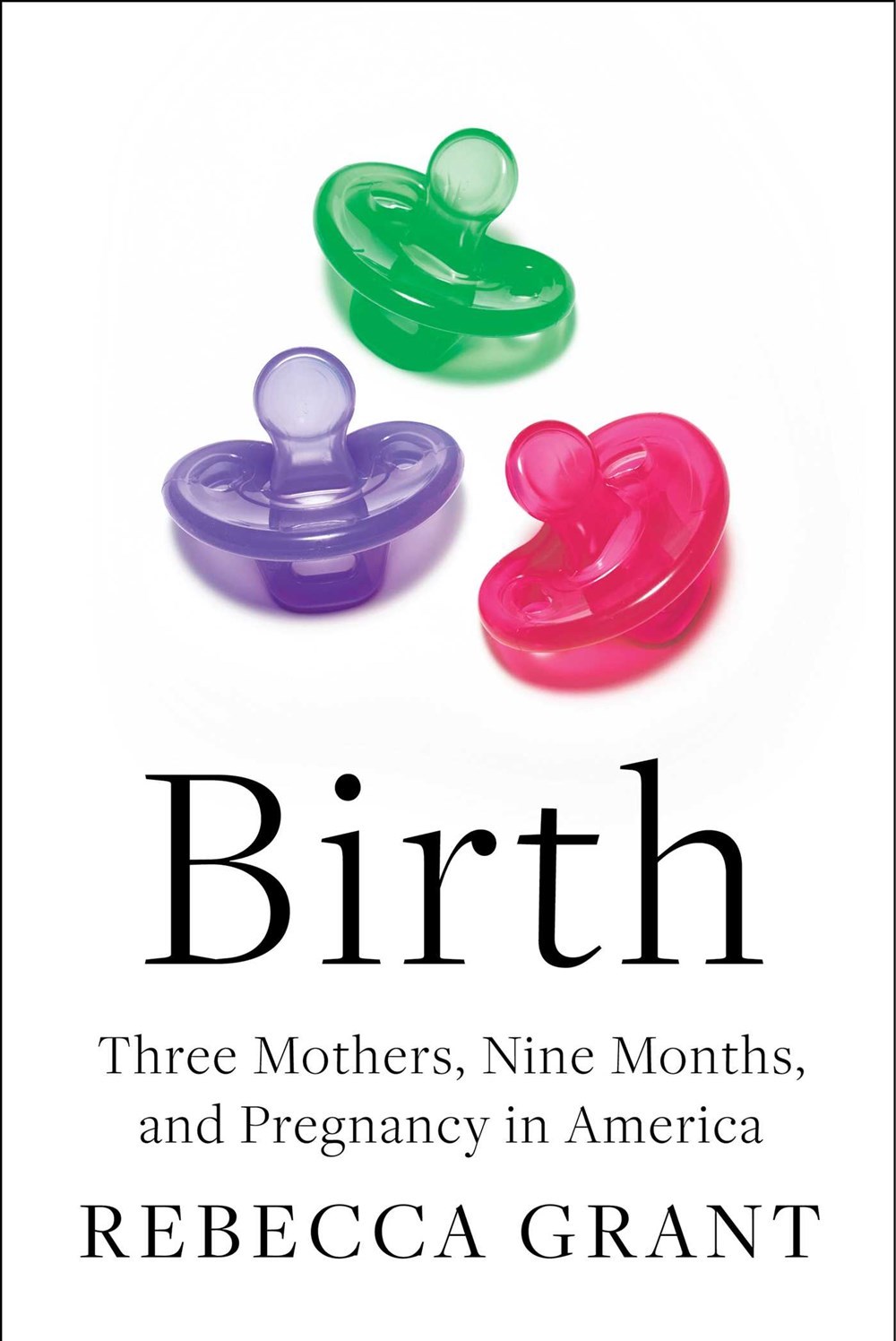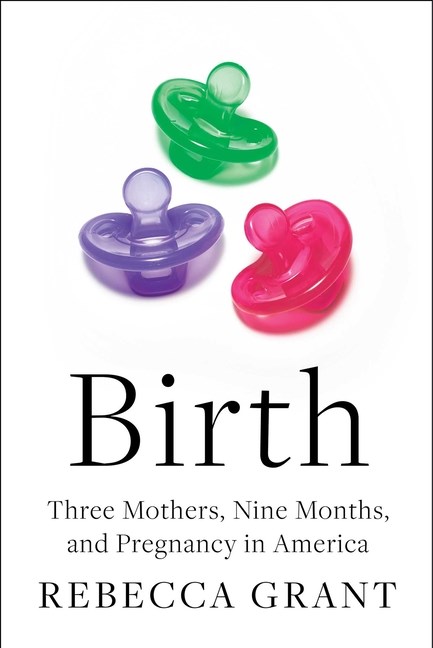Birth: Three Mothers, Nine Months, and Pregnancy in America
May 05, 2023
“This is the birth system that most expectant mothers encounter in America,” Rebecca Grant writes in the opening of her new book, Birth. “But what if it could be different?”
Birth: Three Mothers, Nine Months, and Pregnancy in America by Rebecca Grant, Avid Reader Press/Simon & Schuster
Ever since my partner and I got engaged last fall, I’ve been asked whether I want to have children, but I have never been asked how I want to proceed through a future pregnancy and childbirth. The assumption, no doubt, is that I’ll go through it the way everyone else in recent memory has. But let’s consider childbirth in the United States not as what it largely is today—a medical intervention—but rather, as an event. In The Art of Gathering, Priya Parker notes that “we often let old or faulty assumptions about why we gather dictate the form of our gatherings.” With how life-changing an event childbirth is, we have largely accepted a single, unquestioned framework for it.
Here’s how I picture the standard childbirth experience, based on the women in my life who have gone through it previously and its portrayal in popular media: there’s a dramatic rush to the hospital, where the mother is immediately laid out on a bed and hooked up to fetal heartbeat monitors and an IV drip and administered an epidural. She’ll be in this position for hours with nothing but a cup of ice chips to sustain her, waiting until her cervix is fully dilated and her contractions reach the optimal rhythm, or she’ll be whisked away to an operating room if labor doesn’t proceed as usual. Her child will be born in a sensory-overloading environment filled with tubes and wires and beeping machinery and swirls of medical staff.
To me, even the best version of this childbirth sounds deeply distressing, enough to wonder if it is a price worth paying for the creation of my family. “This is the birth system that most expectant mothers encounter in America,” Rebecca Grant writes in the opening of her new book, Birth. “But what if it could be different?”
To explore this question, Grant weaves together her research on the history of childbirth in the United States with the stories of three pregnant women—Jillian, T’Nika, and Alison—who opt to seek care from midwives at freestanding birth centers based in Portland, Oregon. What results is the idea that there is no single childbirth process that is inherently better than the other, but rather, that expecting parents deserve the right to choose the environment and medical providers that make the most sense for their unique needs.
As Grant confirms, a staggering 98% of births in the United States currently occur in hospital settings and include a near-universal battery of interventions:
85 percent of women who labor in hospitals receive continuous electronic fetal monitoring and an intravenous drip. Around one in three pregnant people have their labors induced, while 40 percent report that their maternity care provider tried to induce their labor. 52.4 percent of women said they received Pitocin at some point during their labor. 75 percent get an epidural. 80 percent of people giving birth in hospitals do not eat, and 60 percent do not drink during labor. Most patients are restricted to bed and give birth on their backs […] One in three babies is born via cesarean surgery.
It would make sense for these treatments to be universally applied if they produced universally good results. And yet, Grant reveals that our current method of childbirth results in exorbitantly higher costs compared to other countries yet “ranks lower in health outcomes for mothers and infants than other industrialized countries.” Women of color face an additional burden—in a country where maternal mortality is rapidly increasing overall, Grant notes that "the CDC estimates that rates of severe maternal morbidity are 3.2 times higher among Black mothers than White mothers and 2.3 higher among American Indian and Alaska Native mothers.”
There are deep systemic issues that affect the levels of care that expectant mothers will receive. The legacy of the Jim Crow era still looms large in the form of underfunded hospitals in primarily Black communities and barriers to entry for Black medical professionals. Medicaid eligibility and paid parental leave vary wildly from state to state and employer to employer, leaving mothers and newborns with little to no safety net at a critically vulnerable point in their lives. Age and underlying medical issues will determine whether a person is considered low risk, thus needing fewer medical interventions throughout their pregnancy and childbirth, or high risk, thus needing more intensive treatment.
And yet, with all this variability, childbirth has become a virtually uniform process, and not one led by birthing individuals themselves. The highly hands-on, systematized version of childbirth that we may consider an unquestionable norm today is not, in fact, how it has always been performed, and Grant offers a critical history of how our birthing practices got to this point.
Childbirth in the United States shifted in the late 1700s from a female, midwife-led, housebound event to a hospital-based intervention led by male physicians who saw pregnant women as “golden business opportunities.” Male doctors, Grant notes, were willing to introduce obstetric tools and surgical procedures to make labor a more expedient process, and staging births in a hospital allowed physicians to quickly treat multiple women in a centralized location. These developments aren’t all bad, as many women in higher-risk situations have since benefitted from the introduction of surgical interventions to resolve complications that may have been fatal otherwise. But rather than offering those giving birth a wider variety of options to choose from, physicians engaged in campaigns to outlaw midwife-led childbirth outright—and often succeeded. As Grant writes, “Doctors presented themselves as paternalistic protectors and guardians, encouraging their patients to be submissive, yield to their wisdom, and not ask too many questions.”
Today, midwife-led births may feel like a fringe alternative or a relic of the past, but the opposite exists outside of the United States. In Secrets of the Sprakkar, Icelandic First Lady Eliza Reid tells the story of her first pregnancy. A native Canadian, she assumed that childbirth in Iceland would be physician-led as it was back home. Instead, her physician congratulated her, recommended that she take some vitamins, and directed her to visit a midwife instead. Reid admits that her decision to have four children was thanks to Iceland’s fully covered midwife care, access to professional childcare providers, and expansive parental leave policies. Under different circumstances, her family could have been smaller.
We must question, then: who does the current framework of childbirth truly serve? Does it honor the needs of mothers and newborns, or does it prioritize the needs of the medical institution? Rather than being a collaborative process between trained professionals and birthing individuals, Grant asserts that, under the current conditions of childbirth in the United States, “many patients find themselves surrendering to an institution, to systems, and to healthcare providers with little room left to their own needs.”
All three of the women Grant profiles throughout the book have opted to give birth beyond the hospital system because of previous traumatic experiences that left their confidence in the institution shaken. Jillian, an office manager at a birth center and aspiring midwife, had once been left to bleed out for hours in an emergency room waiting room, only to be informed matter-of-factly that not only was her pregnancy no longer viable, but her miscarriage had already completed on its own. Alison, a teacher, was routinely described by her medical providers as “high maintenance” and functionally coerced into processing a miscarriage under general anesthesia, an intervention that was not medically mandatory and that she had explicitly refused. T’Nika, a Black nursing student who had once sought treatment for unidentified gastrointestinal issues and encountered doctors skeptical of her symptoms and unable to find the right treatment for her until a family friend intervened, decided she did not want to experience the same run-around for her prenatal care.
It is important to note that these three women were able to seek alternative care because Portland has a relatively expansive network of midwife-led birth centers, and out-of-hospital care is covered by Oregon’s public health insurance. Whether a midwife can practice depends on each state’s licensing laws and on the type of midwife certification they hold. Nurse-midwives, who are regularly stationed within hospitals, can largely practice nationwide, whereas certified professional midwives who work outside hospital settings are limited or outright barred in certain states.
As Dr. Greg Eilers, an obstetrician and founder of the Midwifery Birth Center notes, hospitals will allocate the same resources and interventions for a low-risk patient as they will for a high-risk patient in the next room over, raising the cost of childbirth for everyone regardless of how much or how little intervention they received.
Both patients had access to the same resources, and someone—the hospital, the insurance company, the patient, or most likely, a combination of all three—was paying a premium for ready access to them. But there was an exceedingly low chance that Patient A would require the same resources as Patient B, and so wasn’t deploying those resources for every single patient, regardless of need, inefficient and wasteful? And wouldn’t it make more sense for Patient A to give birth in a lower-cost environment where all those resources weren’t unilaterally marshaled?
Grant does not present midwife-led birth as a flawless solution to the current state of childbirth but does cite studies showing “that planned home births and birth center births are associated with fewer procedures, easier recoveries, fewer vaginal tears, and lower infection rates.” For individuals with low-risk pregnancies working with licensed midwives, there was virtually “no increase in adverse outcomes or maternal or infant mortality.” Midwife-led births offer birthing individuals the opportunity to choose a birth setting that feels relaxing and safe, whether it occurs in one’s own home or in a birth center equipped with birth tubs and plush beds. Standard hospital environments, on the other hand, offer far fewer environmental options, and the sterile, hectic environment can spark a fight-or-flight response in a stressed laboring patient, which Grant notes can stall labor and end up triggering a “cascade of interventions” to move labor along.
Having access to Jillian, T’Nika, and Alison’s stories provides a much-needed perspective on childbirth, especially needed at a time when reproductive justice is under continuous attack from legislators nationwide. Understanding how limited childbirth options are in the United States today is to witness yet another instance of external forces attempting to exert control over women’s bodies. To identify oneself as pro-choice has primarily been associated with the fight for (or against) abortion rights. In truth, however, reproductive justice goes far beyond just one procedure. Beyond the choice of having or not having children, Grant writes: “Birth choice is a reproductive choice. Everyone having a baby should have the ability to give birth in the environment and with the provider that is the right fit for them.”
The fight for reproductive justice is deeply contentious. My hope is that those who read Birth will be better equipped to face the issue with empathy and understand why change in this arena is so desperately needed. We need to be willing to question the current norms around reproductive care and work to improve them rather than accepting a limited, one-size-fits-all solution. This means expanding access not only to contraception and abortion care but also expanding access to midwives, doulas, and freestanding birth centers. It requires codifying robust legal protections for pregnant workers and introducing a minimum of twelve weeks of universal paid parental leave. Expecting parents should be empowered to make the choices that best suit them. We’re not there yet—but we could be.
This kind of structural change won’t happen overnight, or even in time for my own family plans, but I do feel far more informed after reading Birth, and I hope that other readers come away feeling the same. Childbirth doesn’t have to follow a single template. Even in the face of the limitations of reproductive healthcare today, Jillian, T’Nika, and Alison’s stories, paired with Grant’s rich investigative narrative, prove that we don’t have to passively accept a single version of childbirth. We can—and should—advocate for ourselves and each other and create the birthing experiences that suit us best.




